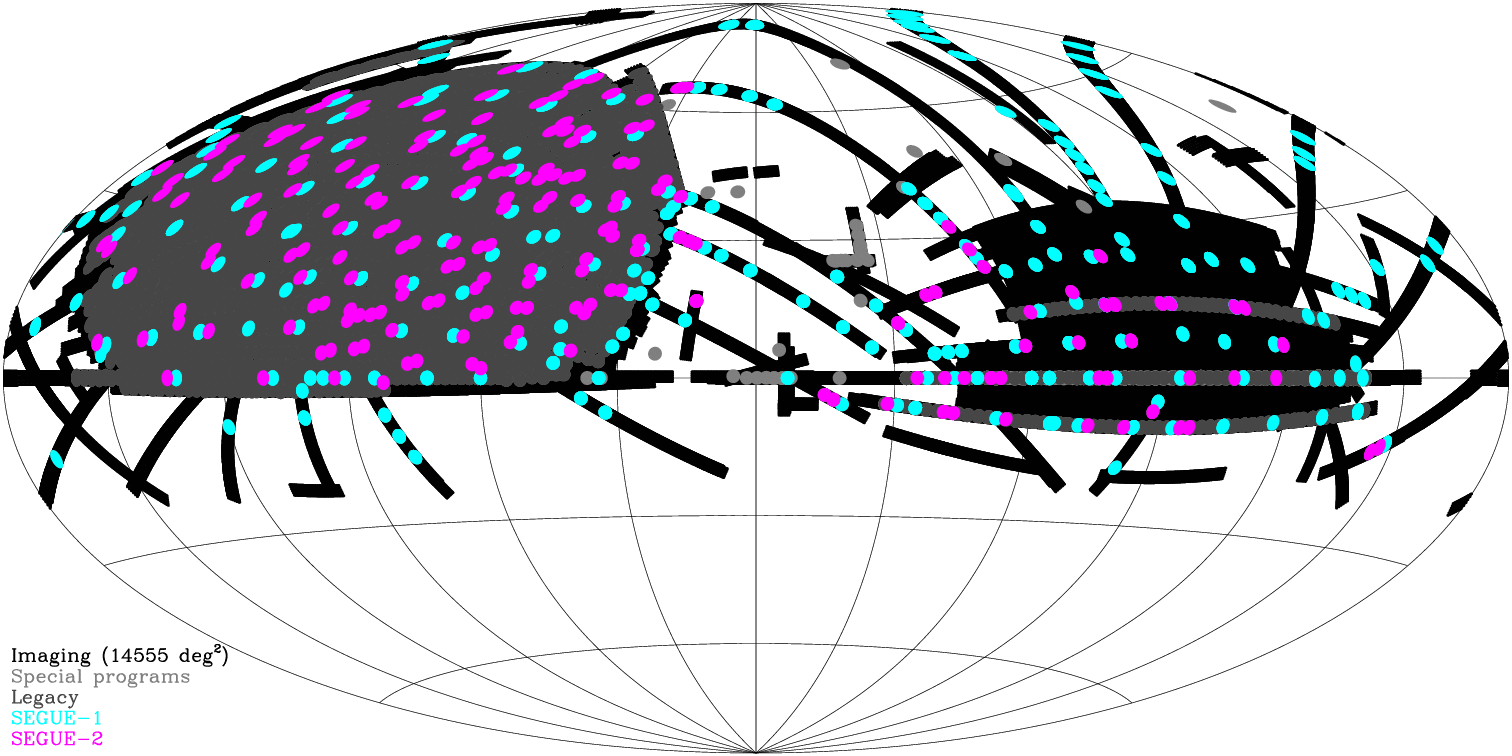Scope
Overview
Data Release 12 represents the culmination of the third phase of the Sloan Digital Sky Survey. It includes all SDSS data taken through 14 July 2014, and encompasses more than one-third of the entire celestial sphere.
With so much sky measured in so many different ways, questions about the size of the SDSS can be answered in many different ways. This page details the SDSS survey area and provides object counts in Data Release 12 in various ways.
Imaging statistics
- Total unique area covered
- 14,555 square degrees
- Total area of imaging (including overlaps)
- 31,637 square degrees (excluding supernova runs)
- Individual image field size
- 1361×2048 pixels (0.0337 square degrees)
- Number of individual fields
- 938,046 (excluding supernova runs)
- Number of catalog objects
- 1,231,051,050
- Number of unique detections
- 932,891,133
- Median PSF FWHM, r-band
- 1.3 arcsec
- Pixel scale
- 0.396 arcsec
- Exposure time per band
- 53.9 sec
- Time difference between observations of each band
- 71.72 sec (in riuzg order)
- Global astrometric precision
- 0.1 arcsec rms (absolute)
- Total
- 469,053,874
- Stars
- 260,562,744
- Galaxies
- 208,478,448
- Unknown
- 12,682
(95% completeness for point sources)
- u
- 3551Å
22.0 - g
- 4686Å
22.2 - r
- 6165Å
22.2 - i
- 7481Å
21.3 - z
- 8931Å
20.5
- u
- 1.3%
- g
- 0.8%
- r
- 0.8%
- i
- 0.7%
- z
- 0.8%
Optical spectroscopy data statistics
All programs combined
- Total spectra
- 4,355,200
- Useful spectra
- 4,266,444
- Galaxies
- 2,401,952
- Quasars
- 477,161
- Stars
- 851,968
- Sky
- 341,140
- Unknown
- 200,490
Stellar (SEGUE)
- Effective area (deg2)
- 1,317
- Plates
- 229
- Total spectra
- 155,520
- Unique objects
- 138,099
Extragalactic (BOSS)
| Statistic | Total | Unique |
|---|---|---|
| Spectroscopic effective area (deg2) | … | 9,376 |
| Plates | 2,512 | 2,438 |
| Spectra | 2,497,484 | 2,269,478 |
| All Galaxies | 1,480,945 | 1,372,737 |
| CMASS | 931,517 | 862,735 |
| LOWZ | 368,335 | 343,160 |
| All Quasars | 350,793 | 294,512 |
| Main | 241,516 | 220,377 |
| Main, 2.15 ≤ z ≤ 3.5 | 175,244 | 158,917 |
| Stars | 274,811 | 247,216 |
| Standard stars | 52,328 | 42,815 |
| Sky | 238,094 | 223,541 |
| Unclassified spectra | 163,377 | 140,533 |
Infrared (APOGEE) spectroscopic data statistics
DR12 includes data for ~163,000 APOGEE targets. This includes 146,000 science targets, located in distinct types of survey fields:
- ~15,000 stars
- in Bulge fields
- ~28,000 stars
- in Halo fields
- ~55,000 stars
- in Disk fields
- ~14,000 stars
- in Kepler/CoRoT fields
- ~8,000 objects
- in Ancillary Science fields
- ~1,800 stars
- in Halo Stream fields
- ~1,200 stars
- in Sagittarius dSph fields
- ~8,000 stars
- in Star Cluster fields
- ~900 bright stars
- observed with the NMSU 1m telescope + APOGEE, including bright standards
Exact counts are given in the table below.
| Statistic | Total | Unique |
|---|---|---|
| Pointings | … | 435 |
| Plates | 2,349 | 817 |
| All stars | 618,080 | 156,593 |
| with NMSU 1-m | 1,196 | 882 |
| Commissioning stars | 27,660 | 12,140 |
| Survey stars | 590,420 | 149,502 |
| with S/N > 100 | … | 141,320 |
| with ≥ 3 visits | … | 120,883 |
| with ≥ 12 visits | … | 6,107 |
| Stellar parameter standards | 8,307 | 1,169 |
| Radial velocity standards | 269 | 17 |
| Telluric line standards | 83,127 | 17,116 |
| Ancillary science program objects | 36,123 | 12,515 |
| Kepler target stars | 15,242 | 7,953 |




